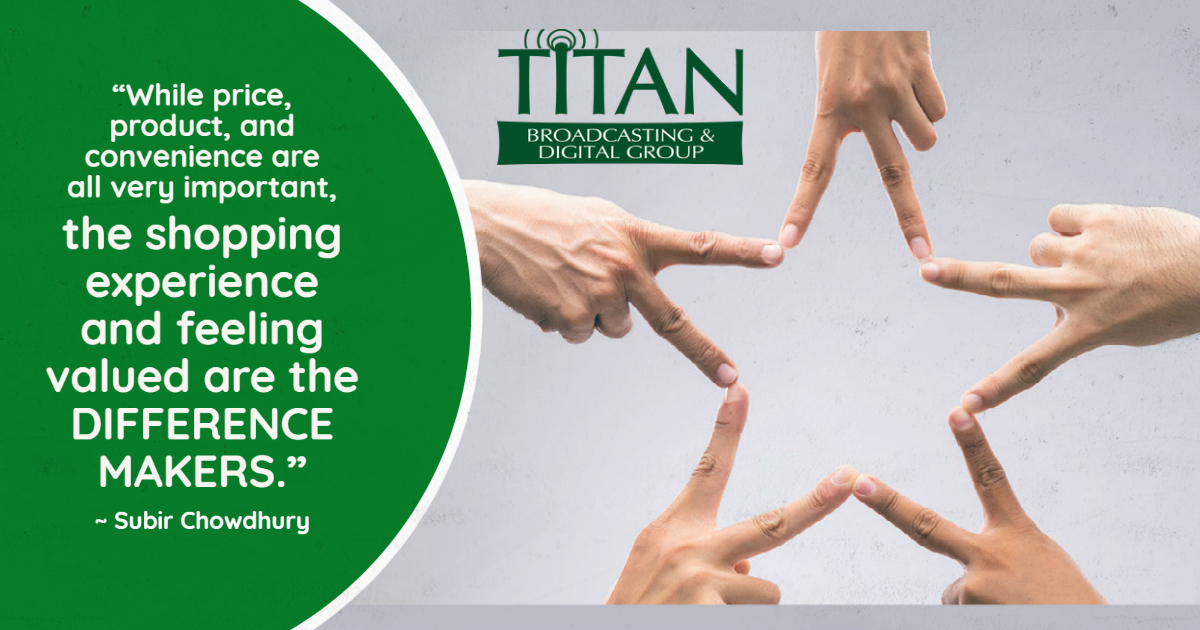
In his book, The Difference, When Good Isn’t Good Enough, Subir Chowdhury asks the question, “If you saw a toothpick on the floor of your office or home, what would you do?”
As a business owner, when you walk in, out, and around your business each day and see small things that litter your business, what do you do?
That question led bestselling author and world-renowned management consultant Chowdhury to a profound discovery. He said, “When it comes to both companies and individuals, good isn’t good enough. The best management systems and processes in the world won’t be effective if you don’t first develop the right mindset to achieve real and sustainable change.”
He concludes, “that the difference is in the ability of organizations to nurture the skills, loyalty, and passion of their people.” Individuals and cultures that draw on a caring mindset focusing on what he calls the STAR principles, straightforwardness, thoughtfulness, accountability, and resolve, thrive. Those that focus on success, processes, and systems alone do not.
Last week we discussed that as consumers become pickier, the competitive nature of nearly all business categories will continue to get tougher and tougher. It’s then, more than ever, where the little things will make a huge difference. Things like:
- Make sure your business’ appearance, inside and out, is presentable and acceptable
- Make sure your phones are answered in a timely and pleasant manner
- Make sure your customers are greeted and dealt with in a way that they feel appreciated
- Make sure your current customers and potential customers understand what you stand for
- Make it easy for your customers to do business with you
Each of these points can be broken down into several areas within your business. While price, product, and convenience are all very important, the shopping experience and feeling valued are the “Difference Makers”.
If tomorrow there is a toothpick, cigarette butt, or other litter around your business, what will you do? The decision you make and the action you take can make all “The Difference” in the world… and in your business!
Suggested reading: The author mentioned above, Subir Chowdhury, is the author of several other outstanding business and leadership books. We strongly suggest reading The Difference, along with The Ice Cream Maker.
If you would like to commit to creating a better experience for your customers and a better environment for your workers, keep reading to see seven steps to help you make positive changes within your company.
Seven Steps to Creating Positive Change
Congratulations! By clicking through you have taken the first step in creating a better culture for your company. The next step is to take action. While the process is not difficult, it does take some time and it definitely takes commitment.
Before getting started, as the owner or leader, you must first be committed to making changes. If you are not, stop here and wait until you are. Going through this process and not following through will cause more harm than not doing anything at all.
There is more than one correct way to approach this process. The process explained below, while not exactly the same, is similar to what Walt Disney companies used to create their theme parks and also used to implement positive changes within the parks and company. Walt Disney companies refer to it as Story Boarding.
The following are simply suggestions to help you get started:
Step 1: Identify the people/employees that you want involved in the process. This can be from everyone to a select few. Both have advantages and disadvantages. You can also ask for volunteers. This ensures that those not involved don’t feel left out.
Step 2: Set up planned times to hold the brainstorming sessions. It will take more than one meeting. After the first meeting, participants will continue to think about and uncover additional thoughts and ideas.
Step 3: Create topics: See the article for topics. Each of the 5 areas listed can be broken down into individual topics, i.e. Physical appearance of Building – Inside and out. (Signage, Landscaping, Check-out area, Restrooms, Dressing Rooms, Office Areas), How phones are answered and how replies to customers are handled, emails, texting, etc. What is your perception within the community now and what do you want it to be? How do you change the perception?
Step 4: Meet with participants: Set ground rules. Establish what you are trying to accomplish. “Create a better experience for our customers and a better working environment for our employees”. There are no stupid questions or suggestions, only ideas. In the first or even second meeting, you should not debate the ideas thrown out. Simply write them down (preferably on a board that everyone can see) and leave all ideas up until the conclusion of this meeting or the entire process. You will want all participants to refer to these ideas throughout the process.
Step 5: Re-visit all ideas and dissect: Kick out or eliminate ideas that are not worthy. Then, break down all other ideas until you have come up with solid thoughts on how to make changes or improvements.
Step 6: Create a priority list and a timeline: Select the ideas that should be implemented first and in what order and a timeline for getting it implemented or accomplished.
Step 7: Action!
The Results: A better customer experience, which will create more loyal customers, larger and more regular purchases, and better word-of-mouth advertising. Plus, better and more loyal employees.
At Titan Broadcasting and Digital Group, we believe our responsive, on-going communication with our clients is one of the biggest reasons why our partnerships are so successful. Whenever you need us, we’ll be there by your side to answer your questions and help your business grow in any way we can! www.titanburlington.com/contact-us/
Recent Comments